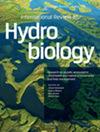The role of visual and physiological refuges in humic lakes: Effects of oxygen, light quantity, and spectral composition on daytime depth of chaoborids
Abstract
To clarify the effect of brownification on the functioning of lake ecosystems, the utilization of daytime refuges by chaoborids was examined in two lakes having different water color. It was hypothesized that with high water color, oxygen concentration plays a smaller role for the behavior of chaoborids than with lower water color. It was also expected that the depth distribution of chaoborids is associated with light intensity at 680–700 nm. This could decrease their visibility to predators. In Lake Iso Valkjärvi with 50 mg L−1 Pt water color, chaoborids occurred below 5 m depth, where the oxygen concentration was 0.4 mg L−1. Supporting the first hypothesis, in Lake Majajärvi with 340 mg L−1 Pt color, the leading edge of the population was at 3 m with 3.5 mg L−1 oxygen concentration. In Majajärvi, chaoborids remained in a layer where planktivorous fish could feed, explained by the low light intensity that decreased the potential predation pressure of fish. In Iso Valkjärvi with higher light intensity, chaoborids inhabited only the layers where oxygen concentration was too low for fish. Supporting the second hypothesis, the intensity of 693 nm light in the two lakes was similar at the depth of the leading edge of the chaoborid population. This wavelength represents the wavelengths that chaoborids reflect most effectively and is beyond the sensitivity peak of their main predator perch. The results suggested that combined effects of oxygen and water color are potential explanatory mechanisms of the observed patterns in the behavior of chaoborids. The results thus suggested that along the worldwide brownification of lakes, the role of oxygen as a regulator of invertebrate predators may change. Because invertebrate predators are important components of lake food webs, such effects may be reflected to the whole ecosystem and further studies on the subject are encouraged.

 求助内容:
求助内容: 应助结果提醒方式:
应助结果提醒方式:


